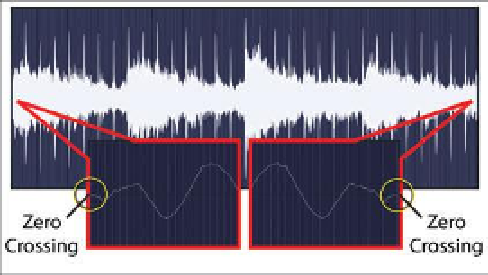Game Development Reference
In-Depth Information
that will not become overtly repetitive. It also takes a highly skilled composer to know how much melody
to include in looping musical passages. Too much and you may drive the listener bonkers, too little and
there may not be enough tension or development to hold their attention. Similar to i lm music, often the
best kind of loop is the one you don't even hear because it's so well integrated with the game.
Creating Perfect Loops
Creating suitable loops is an art form in itself. So now that you know how
important looping is, how do you do it?
Looping often starts in a DAW. Loops are self-contained audio regions,
that are sourced or recorded and then cut, trimmed and tested to make
sure they do not skip. It is a good idea to test your loops in a stereo
editing program like Sound Forge or Adobe Audition after you bounce
them out of your DAW to make sure that your ear is not being fooled and
that they are in fact seamless.
Be patient—sometimes it can take a while to i nd a seamless loop point,
you may i nd yourself blowing up the waveform to quite an extreme
degree in order to i nd a suitable zero crossing point. What's that? Well,
a sound waveform graphically goes up and down
around a center point of no volume. A seamless
loop can most likely be created when the end of
the loop and the beginning of the loop cross the
exact center of the waveform where the volume of
the wave is essentially zero. This is known as a “zero
crossing” and it is vital to avoid clicks and pops.
If you're only selecting a loop of a few waveform
cycles you can visually see the beginnings and
endings of loops easily on the screen. However, for
longer loops you may need blow up the waveform
view to a more extreme magnii cation. Then you will
set your loop markers, listen, and gradually change
your marker points until a suitable zero crossing is
found.
This image shows how to get a seamless loop by using a zero crossing to
smooth the transition point between the beginning and end of the i le.
Credit:
Jeremy Engels.
In some cases, it may be necessary to fade the
waveform in or out, or you may also need to redraw the very end point
of a wave i le to avoid that pop or click. The length of the fade in/out
will depend greatly on the situation. If you're trying to create the best
example of a continuous fan hum or an ominous turbine sound in an
engine room then you may be reducing the length of your fades to mere
milliseconds in order to avoid an obvious sense of the sound fading in

































